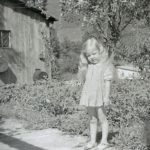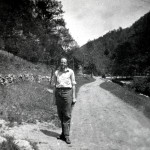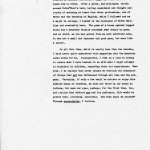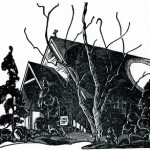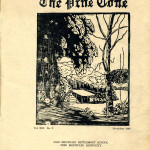Pine Mountain Settlement School
Series 09: BIOGRAPHY – Staff
John A. Spelman III, PMSS Artist-in-Residence, 1937-1941
John Adams Spelman III (1912-1969)

1938 Calendar. Linoleum block print by John Spelman III. Hemlocks and mountains. [1938_calendar_001-e1588288031922.jpg]
TAGS: John A. Spelman III, artists ,poets, writers, art education, linoleum blocks, woodcuts, prints, landscapes, Asheville (NC) Farm School, Black Mountain College, Progressive education, Barbara Spelman, Christmas cards, commemorative calendars, print shop, William and Fern Hall Hayes, Spruce Point Lodge, Hovland Minnesota
JOHN A. SPELMAN III Staff
Art Instructor, Houseparent,
Artist-in-Residence 1937 – August 1941
BIOGRAPHY
These are my hills…I bought and paid for them with work…not of the plow and pick…but by painstaking observation…the work of the pencil and the brush…I was not born among them…yet they are mine…for what I have seen I have made anew, part of myself…part as preservation of what shall pass…. [(From an untitled free verse poem by John A. Spelman III in the April 1987 issue of Notes from the Pine Mountain Settlement School]. JAS II

102 John Spelman III. [burk_people_102.jpg]
John A. Spelman (1912-1969) could indeed lay claim to the mountains of Appalachia as he skillfully captured their essence in drawings, paintings, prints, poems, plays, and teaching during his employment at Pine Mountain Settlement School from 1937 to 1941. To this day, he is primarily remembered and admired for his linoleum-block and woodcut prints representing both life and the surrounding natural environment of the mountain people.
In the sense that Spelman’s strongest works were landscapes and rural scenes, he followed in the footsteps of his artist father, John A. Spelman II who was an award-winning artist and a graduate of the Chicago Art Institute.
But Spelman developed his own creative style, particularly during his years at the Settlement School. His interest and work in the medium of linoleum block printing has attracted many followers over the years and continues to define the mountain cabin in ways that convey the dignity and beauty of that vernacular architectural style.
John Adams Spelman III was born on July 16, 1912, in Oak Park, Minnesota, the only son among the four children of John Adams Spelman II and Florence Seis Spelman. His sisters were Ellen G., Marguerite, and the youngest, Barbara, who worked briefly at Pine Mountain.
SPELMANS in North Carolina
The Spelman family had a long history with the North Carolina Mountains. John Spelman II often came to the area to paint with his fellow artist Rudolph Ingerle and to also hunt and hike in the mountains. John Spelman III, his son, came back to the South in the mid-thirties looking to expand his art and his life experience. He may have been first attracted to the art and artists of nearby Black Mountain College though there is no record of his enrollment in the college founded by John Andrew Rice and Theodore Dreseir in 1933. Spelman found employment close by in what was then called the Asheville Farm School in the Swannanoa Valley, near Black Mountain College and to Asheville, NC where the Spelman family had frequently spent their summers.
Hired by Arthur Bannerman, President of the Farm School, Spelman III, found the employment at the Farm School a bumpy road but one that led to Pine Mountain Settlement School. In the unique North Carolina Farm School program at Swannanoa, students were required to work on campus at various jobs to off-set their tuition. Later, this compulsory work and their regular academic program, grew to included community service. With deep roots in the Appalachian settlement school ethos and connections to the earlier Dorland Bell School, a United Presbyterian mission school, the broad communal program in the 1930’s Swannanoa Valley was well known to the Pine Mountain Director, Glyn Morris. The Pine Mountain Settlement School Collection contains regular exchanges between Glyn Morris and Asheville Farm School directors, particularly Arthur Bannerman. [See Bannerman-Morris correspondence.] In 1942, the Farm School merged with Dorland-Bell School, a mission school, to later become what is now Warren Wilson College where another Pine Mountain employee, Birdena Bishop, found employment late in life as a housemother.
JOHN SPELMAN III At Asheville Farm School and Black Mountain College
In approximately 1936, though there is no evidence, Spelman III possibly attended the experimental Black Mountain College. The program there, similar to that at Pine Mountain in the 1930’s was strongly indebted to John Dewey and to the Progressive Movement. Although Spelman is reported to have indicated that he had an association with Black Mountain College, there is no record of his enrollment, a fact common with some students who passed through the institution for a brief time, or, in Spelman’s case, possibly through frequent visits as the College was near the Asheville Farm School. The community of Black Mountain College, while small and short-lived, attracted many of America’s influential visual artists, poets, and designers as instructors. These included, among many others, Josef and Anni Albers, John Cage, Merce Cunningham. Buckminster Fuller and encompassed experimental courses in architecture, painting, dance, music, and many arts/crafts experiments.
Spelman’s time at the nearby Asheville Farm School, where he was an art instructor in 1936-1937, allowed him to practice his skills and to enjoy the association with the artists at Black Mountain College. To what degree this proximity helped to shape Spelman’s art, his poetry and his teaching at Pine Mountain Settlement is not fully known, but there are many signs that a Black Mountain College association was a formative encounter for Spelman.

John Spelman seated in Laurel House interior at Christmas, c. 1938 [X_100_workers_2562a_mod.jpg]
ARRIVAL at Pine Mountain Settlement School

John Spelman at Pine Mountain Settlement School. Source: Paul Hayes Photograph Album.[hay_IMAG0180_mod.jpg]
The Director of Pine Mountain Settlement School in 1937 was Glyn Morris, a progressive educator who had been strongly influenced by Dewey and many of the ideas endorsed at Black Mountain and at the Asheville Farm School. At Pine Mountain, under the ideals of the early founders and the growing Dewey pragmatism under Glyn Morris, was combined deep respect for the land and for farming. Morris and Bannerman found much in common and as administrators and teachers at the schools, they communicated regularly with one another. Their communication regarding Spelman III was remarkably candid.
When John Spelman III made application to Pine Mountain Settlement School to teach art, his endorsement by Bannerman was not hearty. When Warren Wilson College’s President Arthur J. Bannerman gave Spelman a cautioned endorsement, it was clear he recognized the young artist’s talents but cautioned Morris as to Spelman’s labile temperament and he encouraged Morris to hire him on a trial basis and if acceptable then offer him a full position. This was the agreement that Spelman III accepted.
Spelman obviously felt at home at Pine Mountain and he stayed for nearly three years where he was, as described by Bannerman, a temperamental and inspired and inspiring artist. During the three years Spelman grew his coping skills and his art skills. At Pine Mountain he made life-long friends and eventually encouraged his sister, Barbara Spelman (later, Mrs. Collin F. Allen) to join him following her graduation. Barbara worked in the School’s Office as a bookkeeper, and by all accounts was quite skilled and during her time she also provided John a point of stability and support. Though her tenure at Pine Mountain was short, Barbara, like her brother John, established lifetime friendships with many of the staff at the School.
JOHN A. SPELMAN III: The Artist’s Work

The Chapel. A woodcut by John A. Spelman, published in the October 1938 issue of Notes from Pine Mountain Settlement School. [pmss_archives_notes_spelman_1938_oct_004.jpg]
Spelman’s talent was noted by First Lady, Eleanor Roosevelt, who wrote about Spelman’s 1938 School calendar in her syndicated newspaper column, “My Day” on January 22, 1938:
I have received a number of calendars from the Pine Mountain Settlement School. This school in Harlan County, Kentucky, is devoted to the education of mountain children. I am delighted with the linoleum cuts which have been used in making up this calendar. Mr. John A. Spelman III made them and he has chosen to portray scenes from the mountain environment and has done it delightfully. The students set up the pages and printed them.
AT HOME IN THE HILLS: Glimpses of Harlan County, Kentucky
![Book of linoleum-block prints by John A. Spelman, 1938 [reprinted 1979]](https://pinemountainsettlement.net/wp-content/uploads/2013/11/pmss_photo_spelman-book-226x300.jpg)
Book of woodcuts and linoleum-block prints by John A. Spelman, 1938 (Reprinted 1978). [pmss_photo_spelman-book.jpg]
John A. Spelman, a new volunteer art instructor, who worked in conjunction with [Art Teacher], Mrs. [Alice] Shera, also spent a lot of time with me in the print shop because of his interest in printing. He lived alone in a one-room log cabin midway uphill on the path between the swimming pool and Farm House.
First, he would make preliminary sketches of off-campus mountain homes, fences, or buildings that intrigued him. He would redraw or refine a sketch in his cabin or the print shop. Then, Spelman would transfer the drawing onto linoleum, which was glued on a type-high woodblock, and tool the linoleum with hand-held gouges. After proofs were made, Spelman would re-work the linoleum until he achieved the desired effect. When his printing was completed, he would store the blocks for future re-use. Spelman also made a few woodcuts, but he preferred to work with linoleum.

“Aunt Sal’s Cabin” by John A. Spelman III. Source: Silver Jubilee issue of Notes from the Pine Mountain Settlement School, 1938. [PMSS_notes_1938_jubilee004.jpg]
August Angel recalls that, “When I later left Pine Mountain Settlement School in the summer of 1937, Fred J. Burkhard of Liberty, Kentucky, replaced me as printing instructor at Pine Mountain. He worked with John Spelman to print, publish, and bind a book of the stored linoleum cuts. It was the first edition of At Home in the Hills.... Some years [later] I relocated to Viper, Kentucky, and established a modern print shop. As a fundraising promotion in 1978, Spelman’s At Home in the Hills got its second printing and was given to any alumni or friends who donated $25 or more to the school.”
August Angel reprinted Spelman’s original 1938 book, At Home in the Hills, in his print shop in Viper, Kentucky in 1978.
From approximately 1939 through 1942, Spelman was also staff artist for Mountain Life & Work, a quarterly journal published by the Council of the Southern Mountains. His linoleum-block prints, sometimes full-page, accompanied articles, poetry, and editorials and reflected his interest in the quiet dignity of the mountain people and the charm of their environment. He expressed this in his poem, published along with his print of a tree against a mountain background, in the winter 1940 issue of Mountain Life & Work :
So much more of beauty now
Upon these hills lies bare
The hemlock’s green against the snow,
The hill-climb’s whitened stair.
LINOLEUM BLOCK PRINTS
Many of the linoleum blocks left at the School by Spelman found their way into later publications such as the Conifer, the Pine Cone and the Pine Mountain Notes. Also, in later years some of his prints were reproduced by former printing teacher August Angel and were offered for sale to benefit the School. A limited number of these prints are still available through the Pine Mountain Settlement School Gift Shop.
Pine Mountain was privileged to have the expert talents of two friends of Pine Mountain in the early 2000s, Scott Husby and Tracey Cullen. For more information about their work on archiving Spelman’s linoleum block prints, go to JOHN A. SPELMAN III Blocks for Prints.

John Spelman III with his father John Spelman II at Spruce Pt., June 1940. (Photo by William Hayes) [grand_marais_24.jpg]
AFTER Pine Mountain
Spelman left Pine Mountain several months after his father’s death in May 1941. He continued his correspondence with Pine Mountain friends and colleagues particularly the Hayes family who had shared housing for John III’s mother to stay for a month in January of 1942 at Pine Mountain. The Hayes couple had formed a close relationship with John’s family In 1940 when he had invited William Hayes and his new bride, Fern Hall Hayes, to Honeymoon at Hoveland, Minnesota, where the Spelman family had their summer home and fishing camp. “Spruce Point Lodge,” possibly named by the Spelmans, was a place that he and his family kept as a special retreat. John III, like his father, returned often to the cabin on the shore of Lake Superior and to those places that held a special corner in his visual memory. That Pine Mountain lingers so long in the memories of those who have visited the School can often be traced to the artistic talents of John Spelman III’s wonderful visual memory and his skills as an artist while working with the settlement institution.
AN APPRECIATION OF SPELMAN’S ART

JOHN A. SPELMAN III: GALLERY I – Spruce Point Lodge, Hovland, MN
- John Spelman beside waterfall near Hovland, MN, June 1940. Photo by William Hayes. [gran_mare_spelman_01.jpg]
- Spruce Pt. dock, June 1940. Photo by William Hayes. [grand_marais_09.jpg]
- Spruce Pt. cabin at Hovland, MN, June 1940. Photo by William Hayes. [gran_mare_08x.jpg]
- Marguerite, younger sister of John Spelman III, at Spruce Point, 1940. Photo, William Hayes. [grand_marais_26.jpg]
- Hovland, MN, on Lake Superior, June 1940. Photo by William Hayes. [grand_marais_16.jpg]
- Seagulls along the Lake Superior coast, Hovland, MN, June 1940. Photo by William Hayes. [grand_marais_14.jpg]
- Head poking through tent at Spruce Pt. camp site at Hovland, MN, June 1940. Photo by William Hayes. [grand_marais_13.jpg]
- Lake at Hovland, MN, June 1940. Photo, William Hayes. [grand_marais_07.jpg]
- Dock on the lake at Spruce Pt., June 1940. Photo, William Hayes. [grand_marais_09-1.jpg]
- Fern Hall Hayes with the catch of the day. Spruce Point, 1940. Photo by William Hayes. [grand_marais_19.jpg]
- Trout. Spruce Pt. cabin, June 1940. Photo by William Hayes. [grand_marais_25.jpg]
************
John Adams Spelman III died on October 22, 1969, in Grand Marais, Minnesota, and was buried in Old Settlers Cemetery in Hovland (Cook County), Minnesota. His gravesite is adjacent to that of his father.
- John A. Spelman II – gravesite. Source: Tracey Cullen. [pmss_archive_grave_JASII-1.jpg]
- John A. Spelman III – gravesite. Source: findagrave.com.[pmss_archive_grave_JASII-1.jpg]
SPELMAN Reflections on Art and Life
In November 2000, Pine Mountain Settlement School filed a petition “Lands Unsuitable for Mining,” with the Department for Surface Mining Reclamation and Enforcement to designate 5,226 acres of surrounding land as unsuitable for coal mining operations. With the assistance of Kentucky’s environmental advocacy organization, Kentucky Resources Council, the effort was successful and lead to the School’s dedication on June 30, 2003, of the James E. Bickford State Nature Preserve. Among the evidence used to support the petition were examples of the works and writings of John A. Spelman III:
The cultural importance of the structures and their relationship to an unspoiled natural environment is evident in the woodcuts and writings of the 1939 volume At Home In The Hills by John A. Spelman III. In the second chapter of his book, Spelman reflects in word and linoleum woodcut, on the significance of Pine Mountain and the school ‘founded for its people . . .[i]n the midst of these remote hills of Harlan County.’ (The second chapter is reprinted as Appendix I.)
THE SEASON’S TURN
I’ll go back soon to hills I’ve known
Where skyline is not straight, but grown
In rugged, ruffled, rising peaks
Of stone and trees and earth. Where shrieks
The winter’s wind, and cloud-tufts cling
To freeze in webs of ice till Spring.

John Spelman, III, standing in the road near the Office at PMSS. [X_099_workers_2500_mod.jpg]
I’ll go back soon to hills that bleed
When cloud-bursts lash the first grown weed
With singing knives of silver’d rain,
And waters wash and whirl earth’s stain
Down creek bed’s crooked, winding way —
Severed and lost from its hillside clay.
I’ll go back soon to hills I’ve known
To find again the greens now grown
Upon each ridge in emerald hues;
Where great clouds float against the blues
Of sky and fling their shadows flat
Against the hillsides’ leafy mat.
I’ll go back soon to hills that burn
With autumn’s haze; when season’s turn
To pay last tribute to the bud
Of spring and summer’s verdant flood …
With ev’ning’s distant cowbell’s toll,
Tomorrow’s winter descends the knoll.
John Spelman III
from Notes 1940
Found with Spelman’s poem were a series of notes and reflections by Spelman as he tried to sort out his response to the region and how the people of the mountains are challenged in their aesthetic and intellectual response to their environment.
There is more of everything here in the hills than one can absorb, sensuously, emotionally, intellectually, or spiritually. I know that I came here with more than just the intention to teach. There is so much of everything one can’t give enough; neither can one take enough — there is too much. You live, you’re at step and are sheltered [?] Your social intercourse is abundant. Living does not end here, for you step from the house and there before you is everything — so much that your heart is heavy, you could weep, you are restless, you are dumbfounded, you want to tell someone, everyone!
So much, why don’t people see it?
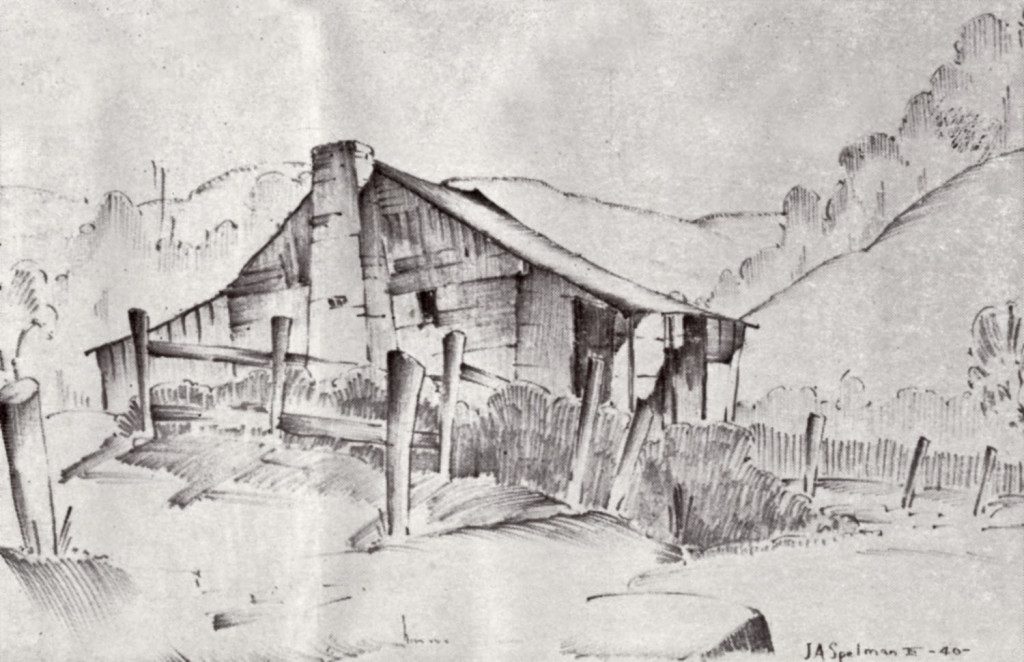
1941 Calendar, “July” page. Drawing by John A. Spelman III. [1941_calendar_007.jpg]
Or is it my desire to feel it with my pencil, draw it — my reason for emotional response to it all?
My response to certain kinds of beauty makes my mouth water — others[ ???] this also, to pictures, or any lovely thing, picture, painting, human characteristics, animal, motion, color, etc.
There is also so much of the disenchanting here — educ[ation]. social, econ[omic] , books [??] -living conditions.
Prejudice [??] of response most troubling to me
(Educ[ation] of prog[ressive ?]. systems here too involved in theories, if there must be any they should go to bottom, but the emot[ional] side — less intellectual.
These people are potentially capable both intellectually and emotionally. But, are numb in both — in the emotional and the intellectual.
These reflections were followed by a talk given to his colleagues at the School. It captures much about his personal aesthetic and his educational philosophy but avoids his distress with the educational direction of the School.
ART AND LIFE
August 26, 1940
Art Room Tea Exhibit
I wonder how many of us would be here today if we had had competent guidance to direct our uncertain talents during our elementary and secondary school years? I ask this because, personally, I would not be, at least, not here at Pine Mountain making an effort toward speaking to you this afternoon. I believe I would be in these mountains, that is to say, the Southern Appalachians, but not as a teacher.
If you will excuse the personal reference, I would like to tell you about a few salient facts in my development. My father was an artist, a landscape painter, of the first degree. His oils of the Southern Appalachians were lovely and idealistic. I know that the first consciousness I must have had of a mountain cabin snuggled against a hill was in one of his numerous pictures of the Blue Ridge mountains. He must have painted and sketched hundreds and hundreds of them. Perhaps, because I had seen a few of them and had thought them romantic, but had never known the real life-fact of living in one, I suddenly became interested in drawing houses at an early age. My first vital art experience grew upon me unconsciously, for to me then, Art was painting, not architecture, too. The multitude of houses I designed and drew up was something else; certainly not Art. All through high school I had this rich experience of creativity, but never acknowledged it (p.2. ) as having much, if any, relationship to what I thought was Art. And this experience was not related in any way to my studies in school; otherwise, I might have had time to learn how to study. After a great, and prolonged, circle around Robin Hood’s barn, having considered and thought seriously of entering at least four other professions, one of which was the teaching of English, which I followed out as a major in college, I landed in the mountains of North Carolina and eventually here. The germ of a house against rugged hills and a mountain finally achieved some chance to grow. And no doubt, as you may gather from my work exhibited here, it was bot a small and innocent and good germ, but more like a cancer.
In all this time, which is really less than two decades, I have never quite understood this magnetism that the mountain cabin holds for me. Consequently, I feel at a loss in trying to relate what I have learned to do with what I might attempt to stimulate in children, regarding their art experiences. However, I do realize that never should we overlook the abundance of things that Art has influenced through all time and the present. Certainly, if only a few shall be artists or enjoy this limited means of creation, we must not throw up our hands in failure, but open our eyes, perhaps, for the first time, too, and realize that without Art and its influence, life would be pretty drab, colorless, unlivable. How then shall we proceed? Through appreciation, I believe.

Drawing by John A. Spelman III. [drawing1_spelman_modified.jpg]
JOHN A. SPELMAN III: GALLERY II
- 102 John Spelman III. [burk_people_102.jpg]
- 002_57 John Spelman (left) and Glyn Morris. [burkhard_peo_002-57.jpg]
- John Spellman III on campus road near Office. [X_100_workers_2582a_mod.jpg]
- John A. Spelman III – Photo by William Hayes. [spelman_hayes2.jpg]
- John A. Spelman III on steps to “Little Log” cabin. Photo by William Hayes. [spelman_hayes1.jpg]
- John A. Spelman III, Pine Mountain, KY, 1940. [pmss_photo_spelman.jpg]
- John A. Spelman III notes, page 1. [spelman0021.jpg]
- John A. Spelman III notes, page 2. [spelman0031.jpg]
- John A. Spelman, III notes, page 3. [spelman0041.jpg]
- John A. Spelman, III “Art and Life” talk, page 1, 1940. [spelman0051.jpg]
- John A. Spelman, III “Art and Life” talk, page 2, 1940. [spelman0061.jpg]
- The Chapel. A woodcut by John A. Spelman, published in PMSS Notes, 1938. [pmss_archives_notes_spelman_1938_oct_004.jpg]
- John Adams Spelman, III linoleum print in PMSS Notes 1938. [PMSS_notes1938_jubilee004.jpg]
- November 1940 Calendar with Spelman print. [1940_calendar_011_mod.jpg]
- 1941 PMSS Calendar with Spelman print. [1941_calendar_010_mod.jpg]
- February 1940 PMSS Calendar with Spelman print. [1940_calendar_002_mod.jpg]
- September 1940 Calendar with Spelman print. [1940_calendar_009_mod.jpg]
- Pine Cone 1948, Cover with woodcut by John Spelman III. [pinecone_1948_nov_ cover.jpg]
- Book of linoleum-block prints by John A. Spelman, 1938 (reprinted 1979). [pmss_photo_spelman book]
- “At Home in the Hills” book jacket, front, 1938 (reprinted 1979). [pmss_archives_spelman_bk_cover.jpg]
- “At Home in the Hills” book jacket, back. [pmss_archives_spelman_bk_backcover.jpg]
- John A. Spelman III flyer for memorial exhibit, 1970. [spelman0011.jpg]
SEE ALSO:
BARBARA SPELMAN Staff Biography
JOHN A. SPELMAN III “The Pink Ribbon” A Play
JOHN A. SPELMAN III Blocks for Prints
JOHN A. SPELMAN III Misc. Block Proofs and Prints
SPELMAN SCANNED Linoleum Block Proofs PASSWORD PROTECTED
JOHN A. SPELMAN III Correspondence Set I Staff Record PASSWORD PROTECTED
JOHN A. SPELMAN III Correspondence Set II 1936-1940
JOHN A. SPELMAN III and Family Correspondence Set III PASSWORD PROTECTED
JOHN A. SPELMAN III Drawings at PMSS
1938 PINE MOUNTAIN SETTLEMENT SCHOOL CALENDAR
1940 PINE MOUNTAIN SETTLEMENT SCHOOL CALENDAR
1941 PINE MOUNTAIN SETTLEMENT SCHOOL CALENDAR
ALSO NOTE:
An Exhibit curated by Scott Husby and Tracey Cullen
|
Title |
John A. Spelman III |
|
Alt. Title |
John Adam Spelman III ; John Spelman ; |
|
Identifier |
|
|
Creator |
Pine Mountain Settlement School, Pine Mountain, KY |
|
Alt. Creator |
Ann Angel Eberhardt ; Helen Hayes Wykle ; |
|
Subject Keyword |
John Spelman ; John A. Spelman III ; Pine Mountain Settlement School ; education ; artists ; poets ; writers ; art education ; linoleum blocks ; woodcuts ; prints ; landscapes ; John Adams Spelman II ; Florence Seis Spelman ; Asheville (NC) Farm School ; Dorland-Bell School ; Warren Wilson College ; Black Mountain College ; Progressive education ; Barbara Spelman ; Mrs. Collin F. Allen ; Notes from Pine Mountain Settlement School ; Christmas cards ; commemorative calendars ; Eleanor Roosevelt ; My Day ; At Home in the Hills ; August Angel ; Alice Shera ; print shop ; Fred J. Burkhard ; Mountain Life & Work ; Council of the Southern Mountains ; Old Settlers Cemetery ; Department for Surface Mining Reclamation and Enforcement ; Kentucky Resource Council ; James E. Bickford State Nature Preserve ; petitions ; Mountain Life & Work ; Berea College ; |
|
Subject LCSH |
Spelman III, John A., — 1912 – 1969. |
|
Date |
2009-09-26 |
|
Publisher |
Pine Mountain Settlement School, Pine Mountain, KY |
|
Contributor |
n/d |
|
Type |
Text ; image ; |
|
Format |
Original and copies of photographs, documents, and correspondence in file folders in filing cabinet ; photograph album(s) ; |
|
Source |
Series 09: BIOGRAPHY |
|
Language |
English |
|
Relation |
Is related to: Pine Mountain Settlement School Collections, Series 09: BIOGRAPHY |
|
Coverage Temporal |
1912 – 2000 |
|
Coverage Spatial |
Pine Mountain, KY ; Harlan County, KY ; Oak Park, MN ; Swannanoa Valley, NC ; Asheville, NC ; Liberty, KY ; Hovland (Cook County), MN ; Berea, KY ; |
|
Rights |
Any display, publication, or public use must credit the Pine Mountain Settlement School, Pine Mountain, KY. Copyright retained by the creators of certain items in the collection, or their descendants, as stipulated by United States copyright law. |
|
Donor |
n/a |
|
Description |
Images created by John A. Spelman III or core documents, correspondence, and writings addressed to or from John A. Spelman II ; clippings, photographs, publications by or about John A. Spelman II |
|
Acquisition |
n/d ; 1930s and early 1940s ; |
|
Citation |
John A. Spelman Collection [Series 09: BIOGRAPHY]. Pine Mountain Settlement School Institutional Papers. Pine Mountain Settlement School, Pine Mountain, KY. |
|
Processed By |
Helen Hayes Wykle ; Ann Angel Eberhardt ; |
|
Last Updated |
2009-09-28 hhw ; 2013-11-04 aae ; 2014-05-23 hhw ; 2016-04-08 hhw ; 2016-04-23 aae ; 2016-05-01 ; 2016-05-27 aae ; 2022-11-17 hhw ; 2025-04-15 aae ; |
|
Bibliography |
Sources Angel, August D. Trivia & Me: An Octogenarian Mirrors His Twentieth Century. London, KY: August David Angel, 2007. Print. “John Adam Spelman III.” Series 09: BIOGRAPHY. Pine Mountain Settlement School Institutional Papers. Pine Mountain Settlement School, Pine Mountain, KY. Archival material. Mountain Life & Work. [untitled linoleum cut and verse]. 15.4 (Winter 1940): 10. Print. Notes from the Pine Mountain Settlement School. XIII.I (October 1940): 4. Print. Notes from the Pine Mountain Settlement School. XI.I (October 1938): 4. Print. Roosevelt, Eleanor, and Rochelle Chadakoff. Eleanor Roosevelt’s My Day: Her Acclaimed Columns, 1936-1945. New York: Pharos Books, 1989. Print. Spelman, John A. At Home in the Hills: Glimpses of Harlan County, Kentucky, Through the Media of Linoleum Block and the Woodcut. Pine Mountain, Ky: Pine Mountain Print Shop, 1939. [Reprinted by Graphic Arts Press, Viper, KY, in 1978.] Print. Spelman, John A. “The Season’s Turn.” Notes from the Pine Mountain Settlement School. XI.1 (October 1938): 4. Print. Spelman, John A. [untitled free verse poem]. Notes from the Pine Mountain Settlement School. (April 1987). Print. Stewart, Al. “The Gift of the Stranger: The Pine Mountain Prints of John Spelman III,” Appalachian Heritage Volume 11, Number 1, Winter 1983 pp. 4-10. “United States Census, 1930”, database with images, FamilySearch (https://familysearch.org/ark:/61903/1:1:XST2-V8W : accessed 28 May 2016), Florence Spelman in entry for John A Spelman, 1930. Internet resource. Illustrations and writings by John A. Spelman III are included in the following books: Campbell, Marie, and John A. Spelman. Cloud-walking. New York: Farrar & Rinehart, Inc, 1942. Print. Clark, Thomas D, and John A. Spelman. The Kentucky. New York: Farrar & Rinehart, 1942. [Reprinted as a Bicentennial Edition by the University Press of Kentucky, Lexington, in 1992.] Print. Archived papers and prints by John A. Spelman III are located in the following collections: Berea (KY) College Hutchins Library Special Collections, Southern Appalachian Archives: Pine Mountain Settlement School Collection. Part 1, series V-IX. Archival material. Pine Mountain (KY) Settlement School Archives. Archival material. |
Return To:
BIOGRAPHY – A-Z




